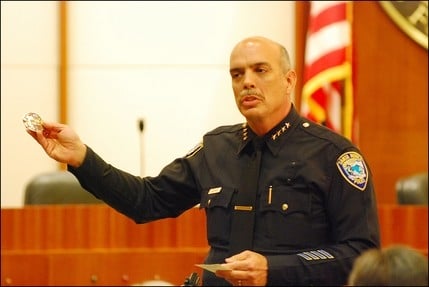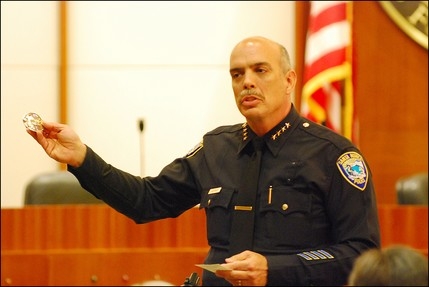
PUBLIC SAFETY FACILITY — Santa Monica Police Chief Tim Jackman is stepping down from his post as the city’s top cop.
Jackman, 52, who was appointed chief in December 2006, informed his command staff Tuesday that he would be retiring at the end of the year, but would remain on the job as interim chief until March when his predecessor is expected to be selected, sources said.
A nationwide search will be conducted over the coming months with applicants coming from within and outside the SMPD, those familiar with the process said.
The SMPD has over 400 sworn and civilian employees and a budget of over $67 million.
“I have a great appreciation for what he has done,” City Councilman Bob Holbrook said of Jackman. “I think he has been an excellent chief of police and I’m really surprised he’s retiring. I really appreciated his kindness, his honesty, forthrightness and his great sense of humor.”
Jackman replaced James T. Butts, who retired after 15 years with the SMPD to oversee security at Los Angeles World Airports, the department which owns and operates Los Angeles International Airport, Ontario International Airport, Palmdale Regional Airport, and Van Nuys Airport. Butts is now mayor of Inglewood.
Before being hired by former City Manager Lamont Ewell, Jackman, a former Marine with an MBA from the University of California, Irvine, spent nearly 24 years with the Long Beach Police Department, where he worked in every major command and left as deputy chief.
Known for his affable, collaborative leadership style, Jackman worked with the rank-and-file to institute the Neighborhood Resource Officer Program, which divided Santa Monica into eight distinct beats or neighborhoods with one officer assigned to manage them. The community policing model is credited with improving the relationship between residents, merchants and officers on patrol, and helping keep crime at record lows.
Jackman also oversaw the creation of a crime mapping system that allows the public to see when and where crimes have occurred on an interactive map, and he allowed officers on patrol to switch to a 3/12 work week, with cops putting in an extra 10-hour shift each month to reach the appropriate number of hours per pay period.
That move cut down on overtime pay and shortened response times, Jackman said in July 2009, nearly a month after the switch went into effect. Jackman said he was skeptical at first of the switch, but was encouraged by research done by officers under his command.
Jackman also responded to criticism. He encouraged his staff to create a cold case unit to clear a backlog of DNA collected from victims of sexual assaults that had not been processed.
But one thing Jackman can be most proud of is a decrease in gang violence, he said. In the last 23 months, there has not been a gang-related homicide in Santa Monica, something he attributes to stronger collaboration between City Hall, nonprofits and residents.
“The legacy that I hope to leave is that people have more faith in their government and feel that they are safer,” Jackman told the Daily Press Tuesday. “It’s been an incredible journey and I’ve enjoyed my time here, but all good things must come to an end.”
Jackman was at the helm when the SMPD came under fire in 2010 for its handling of the Oscar de la Torre investigation in which the school board member was wrongly accused of child endangerment for allegedly failing to quickly break up a fight between two teens.
It was later determined by the Los Angeles County Office of Independent Review that the lead investigator’s actions were questionable, his report containing an “unusual mixture of facts and advocacy.”
Jackman later took full responsibility for the flawed probe, which did not lead to any charges being filed against de la Torre. Since, de la Torre has demanded an apology from the chief but said he has not received one.
Jackman was also chief when one of his commanders, former Capt. Mark Smiley, sued the SMPD, City Hall, Jackman and former Deputy Chief Phil Sanchez for damaging his reputation and for retaliating against him after he acted as a whistle-blower against Sanchez.
Smiley was awarded a $500,000 settlement by the City Council in December of 2008.
Jackman said he is prohibited from commenting on the Smiley matter. When it comes to the de la Torre investigation, Jackman admitted that it highlighted internal issues that needed reform and has enacted all of the recommendations handed down by the Office of Independent Review.
“Any time that you are a chief executive of an organization, you are going to have some issues,” Jackman said. “To have one or two over five years is pretty good. I don’t consider them blemishes.”
de la Torre said even though he is still angered by the investigation and its negative impacts on his reputation, he said Jackman was the most collaborative chief he has worked with, and “the most human.”
“When it came to gang violence, he did not do what his predecessors did, which historically was to ignore the problem,” de la Torre said. “I think a combination of after-school programs, good public schools and law enforcement has decreased gang membership in Santa Monica to an all-time low.”
de la Torre said the next chief of police should work to ensure that all officers treat people with respect and never abuse their power for personal or political gain.
Representatives with the Santa Monica Police Officers Association did not return phone calls seeking comment.
Jackman said he has no advice for whomever is selected, but he plans to help them acclimate in any way he can. After that, he hopes to spend time with family before deciding on his next chapter.
“I’m not retiring to put my feet up,” he said. “That’s not my nature.”
kevinh@www.smdp.com









